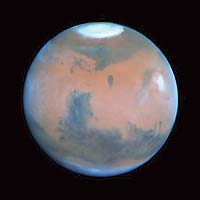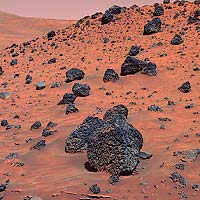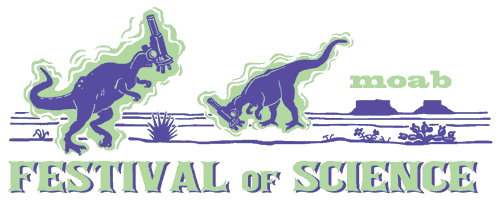SCIENCE HAPPENINGS September 2020 |
| Join the Moab Festival of Science online, in-person, and on the radio! |
The Moab Festival of Science is back for its 5th annual celebration of biology, astronomy, geology, and more, with fantastic virtual and spatially distanced events that everyone can enjoy! We’ll have the rare opportunity to see and ask the discovering expert about two dinosaur skeletons (Kosmoceratops and Terataphoneus) that were excavated in southern Utah and featured in Jurassic World: Fallen Kingdom. Science Moab will broadcast a special edition radio show on KZMU featuring a panel discussion about how to make scientific research more inclusive of the voices and values of Indigenous and Latinx communities of the Colorado Plateau, |
| The Red Planet Rises by Spencer Stokes, Park Ranger |
 Mars, the mysterious red planet, has captured the attention of earthlings for generations. It’s striking appearance in the night sky, fascinating geological features, relative close distance to earth, and science fiction stories about alien occupants have placed Mars in a unique place in the public’s consciousness. Thankfully, due to the hard work of scientists all around the globe, humankind has a much better understanding of the planet. Even though some of the mystery of Mars has been shed, there are still many fascinating aspects of the planet that will excite even the most hardened astronomer. Mars, the mysterious red planet, has captured the attention of earthlings for generations. It’s striking appearance in the night sky, fascinating geological features, relative close distance to earth, and science fiction stories about alien occupants have placed Mars in a unique place in the public’s consciousness. Thankfully, due to the hard work of scientists all around the globe, humankind has a much better understanding of the planet. Even though some of the mystery of Mars has been shed, there are still many fascinating aspects of the planet that will excite even the most hardened astronomer.Mars is the 4th planet from the sun and second smallest planet in the Solar System. It is terrestrial, meaning rocky in composition, which makes it much more similar to Earth than many other planets. It’s surface is pocketed by craters, much like the moon, but it also has polar ice caps that resemble earths. One of the most outstanding physical features is Olympus Mons, the tallest mountain in the solar system that reaches an absurd height of 72,000 feet in altitude, making it approximately 2.5x the height of Mt. Everest. Another preposterous geological formation is Valles Marineris, one of the largest canyons known to man at over 2,500 miles long, 150 miles wide, and over 23,000 feet deep in some areas it absolutely dwarfs the Grand Canyon. The planet has a thin atmosphere of mostly carbon dioxide, which creates huge temperature swings because it cannot retain heat without a substantive atmosphere. The temperature can be as low as -226’ F and as hot as 95’ F but usually sits around -85’ F. In physical appearance the surface of Mars looks remarkably similar to the geology of Moab. Red rock is the ubiquitous feature that covers the entire landscape. The red coloring comes from iron oxide just like on Earth.  Much of the knowledge about Mars was obtained from both flyby probes and robotic rovers that scoured its surface looking for clues about the planet’s chemistry. The first flyby probe was launched by NASA in 1964 igniting another theater of the space race. The Soviet Union was the first to land a probe successfully on the surface of Mars while NASA was the first to send a probe into orbit around the planet. After the fall of the Soviet Union NASA launched the first operational rover to the surface of Mars in 1996. Since then a handful of countries have launched their own missions with there being 8 operational rovers and orbiters studying Mars currently. Visible to the naked eye, Mars is an easy target for backyard astronomers. In September the planet will rise from the eastern horizon around 10pm. Binoculars reveal the intense color of the planet, and when there are large planet wide dust storms the color will change from a pumpkin orange to a sickly yellow. Even the most rudimentary telescopes will reveal some of the surface details. So get out, bring some binoculars, and checkout one of the most fascinating objects in the night sky! |
| Dead Horse Point is located nine miles north of Moab on US 191, and 23 miles southwest on SR313 (32 miles total.) The visitor center is open from 9 a.m. to 5 p.m. daily. Closed Thanksgiving, Christmas Day, and New Year’s Day. Park admission is $20 per vehicle and is valid for three days. |
 and how science can address environmental justice issues relevant to these communities. The popular Star Party goes online this year with a virtual tour of the cosmos – join in from your own backyard! Events also include an outdoor showing of the movie The Pollinators, and walks with experts on local and migrating birds, biological soil crusts, geology, wildlife, and plants. New this year, the festival will also feature a driving tour with recorded audio-narration of some of the amazing and unusual geologic features that can be seen from roads in and around Moab.
and how science can address environmental justice issues relevant to these communities. The popular Star Party goes online this year with a virtual tour of the cosmos – join in from your own backyard! Events also include an outdoor showing of the movie The Pollinators, and walks with experts on local and migrating birds, biological soil crusts, geology, wildlife, and plants. New this year, the festival will also feature a driving tour with recorded audio-narration of some of the amazing and unusual geologic features that can be seen from roads in and around Moab.